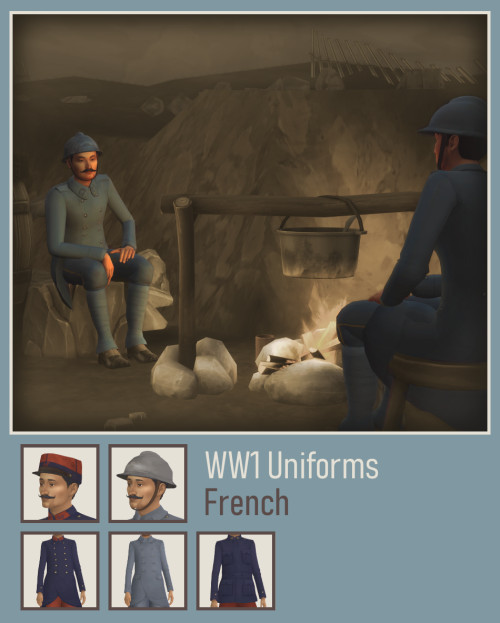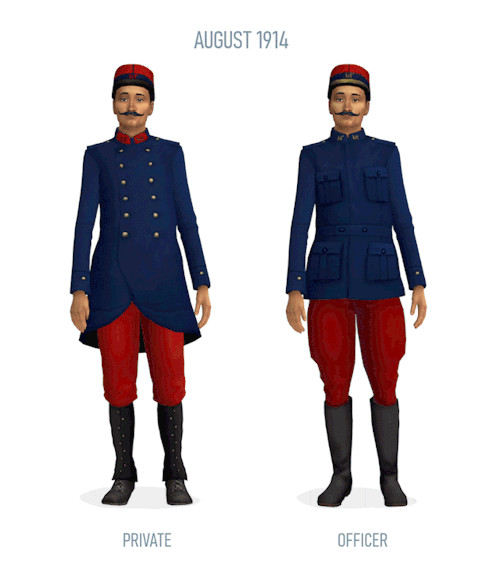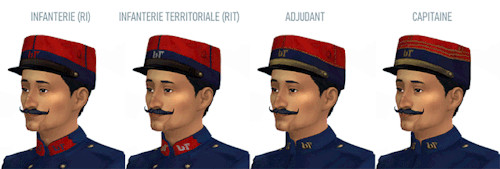The French Army entered World War One in strikingly colorful uniforms, a stark contrast to the drab battlefield attire we associate with the Great War. This article explores the journey of the Ww1 French Uniform, from its outdated beginnings to its eventual modernization in the face of brutal trench warfare.
Initially, French soldiers were outfitted in uniforms reminiscent of 19th-century military fashion. The French WW1 uniform at the war’s outset was based on the 1877 model. This consisted of a dark blue coat and, most notably, bright red trousers. Topping off this ensemble was the képi, a cap in red and dark blue. While visually distinctive, this pre-war uniform proved to be a fatal flaw in the face of modern weaponry.
 French WW1 Uniforms Evolution
French WW1 Uniforms Evolution
The Initial Uniform and its Deadly Shortcomings
The decision to retain the conspicuous 1877 pattern French army WW1 uniform, despite pre-war discussions about modernization, had devastating consequences. The bright colors, particularly the red trousers, made French soldiers incredibly easy targets for enemy fire. This lack of camouflage contributed significantly to the high casualty rates in the early months of the war. Quickly, practical adaptations were needed. Soldiers began using fabric covers, primarily blue, to conceal their brightly colored képis and trousers, attempting to lessen their visibility.
 Animated GIF showing changes in French WW1 Uniform
Animated GIF showing changes in French WW1 Uniform
The Képi: From Colorful Cap to Horizon Blue
The képi, a flat-topped cap, was a standard part of the French military uniform WW1 era. Pre-war, these were produced in red and dark blue. However, the need for better camouflage became immediately apparent. Initially, blue cloth covers were introduced to dull the bright colors. These covers sometimes featured cutouts displaying the regiment number. Within months, these early war képis were replaced entirely by new versions made from horizon blue wool. This color, a greyish-blue, was a significant step towards effective battlefield camouflage. The horizon blue képi remained in service until the introduction of the Adrian helmet in September 1915. Various swatches and officer options existed for the képi, reflecting different regiments and ranks within the French army.
 Swatches of Kepi variations for French WW1 Uniform
Swatches of Kepi variations for French WW1 Uniform
The Adrian Helmet: A Modern Addition
Introduced in September 1915, the Adrian helmet marked a significant modernization of the French soldier WW1 uniform. This steel helmet provided crucial head protection and became an iconic symbol of the French Poilu. Interestingly, its design was heavily influenced by the 1895 French firefighter helmet, showcasing a practical approach to military innovation. Early versions were quite reflective, leading to the quick adoption of beige canvas helmet covers to reduce shine. However, these covers proved problematic, becoming dirty easily and posing infection risks if a soldier sustained a head wound. As a result, new Adrian helmets were manufactured in a matte horizon blue, and older helmets were repainted in the same color. The Adrian helmet continued to be used by French soldiers through to the Phoney War and even by French firefighters until the 1980s, demonstrating its lasting impact.
The 1914 Uniform: Red Trousers in the Trenches
The 1914 French uniform, essentially the 1877 model, quickly proved disastrous. The dark blue coat and bright red trousers were utterly unsuited for the realities of 20th-century warfare. The extreme visibility of the red trousers, in particular, made soldiers easy targets for enemy rifle and machine-gun fire. While blue trouser covers were hastily introduced as a stopgap measure, it was clear a complete uniform overhaul was necessary. This uniform was ultimately replaced by the more practical horizon blue designs.
The Horizon Blue 1915-1918 Uniform: Practicality Takes Over
The horizon blue French uniform WW1, introduced from 1915 onwards, represented a significant shift towards practicality and camouflage. The initial horizon blue uniform was designed by fashion designer Paul Poiret, aiming to conserve fabric amidst wartime shortages. This “Poiret uniform” went through several iterations in a short period, mainly concerning pocket placement and quantity. The version 4 design became the most enduring, lasting roughly from May 1915 to August 1916. However, its lack of warmth, especially noted during the harsh winter of 1914, led to the development of a warmer, double-breasted horizon blue uniform. Although the decision to replace the Poiret uniform was made in August 1915, existing stocks meant the double-breasted version only gradually replaced it from September 1916. The double-breasted French WW1 uniform remained in service for the remainder of the war.
Officer Uniforms: From Distinctive to Blended
French officers initially wore uniforms that, like those of enlisted men, suffered from visibility issues. In some ways, this was even more problematic, as officers were easily identifiable and became prime targets for enemy snipers, aiming to disrupt and destabilize French forces. Efforts were made to mitigate this; officers were instructed to wear trouser covers, coats similar to enlisted uniforms, and képi covers, and to make their rank insignia less conspicuous. They too transitioned to horizon blue uniforms, though initially retaining the cut of their pre-war attire. Influenced by the perceived style of British officer uniforms, a trend emerged amongst French officers from 1916 to 1918 towards adopting English-inspired uniform cuts. By the war’s end, many French officers sported these more fashionable, English-influenced uniforms.
In conclusion, the WW1 French uniform underwent a dramatic transformation, driven by the brutal realities of modern warfare. From the brightly colored, impractical uniforms of 1914 to the horizon blue, camouflage-focused designs that followed, the evolution reflects a crucial learning curve in military adaptation and the prioritization of soldier safety on the battlefield.
